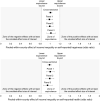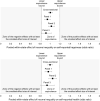The effects of U.S. county and state income inequality on self-reported happiness and health are equivalent to zero
- PMID: 35482148
- PMCID: PMC9188529
- DOI: 10.1007/s11136-022-03137-8
The effects of U.S. county and state income inequality on self-reported happiness and health are equivalent to zero
Abstract
Purpose: A popular idea in the social sciences is that contexts with high income inequality undermine people's well-being and health. However, existing studies documenting this phenomenon typically compare a small number of higher-level units (countries/regions). Here, we use local income inequality indicators and temporal designs to provide the most highly powered test to date of the associations between income inequality and self-reported happiness and health in the USA METHOD: We combined county-level income inequality data (county-level Gini coefficients) with the responses from the General Social Survey (GSS) Cross-sectional dataset (13,000 + participants from ≈1000 county-waves) and Panels (3 × 3000 + participants from 3 × ≈500 county-waves); we used the GSS happiness ("not too happy," "pretty happy," or "very happy") and health ("poor," "fair," "good," or "excellent") variables.
Results: Multilevel-ordered logistic models and equivalence tests revealed that the within-county effects of income inequality on self-reported happiness and health were systematically equivalent to zero. Additional analyses revealed that the within-state effects were identical, that using alternative measures of state income inequality led to the same conclusions, and that lagged effects (between + 1 and + 12 years) were never significant and always equivalent to zero.
Conclusion: The present work suggests that-at least in the USA-income inequality is likely neither associated with self-reported happiness nor with self-reported health.
Keywords: Equivalence testing; Health; Income inequality; Multilevel modeling; Well-being.
© 2022. The Author(s).
Conflict of interest statement
The authors declare no competing interests.
Figures


Similar articles
-
Psychological Mechanisms Linking County-Level Income Inequality to Happiness in China.Int J Environ Res Public Health. 2018 Nov 27;15(12):2667. doi: 10.3390/ijerph15122667. Int J Environ Res Public Health. 2018. PMID: 30486410 Free PMC article.
-
Tract- and county-level income inequality and individual risk of obesity in the United States.Soc Sci Res. 2016 Jan;55:75-82. doi: 10.1016/j.ssresearch.2015.09.008. Epub 2015 Oct 3. Soc Sci Res. 2016. PMID: 26680289 Free PMC article.
-
[Mental income inequality: a "virus" which affects health and happiness].Sante Ment Que. 2013 Autumn;38(2):215-33. doi: 10.7202/1023997ar. Sante Ment Que. 2013. PMID: 24719010 Review. French.
-
Income Inequality and Happiness: An Inverted U-Shaped Curve.Front Psychol. 2017 Nov 24;8:2052. doi: 10.3389/fpsyg.2017.02052. eCollection 2017. Front Psychol. 2017. PMID: 29225588 Free PMC article.
-
Inequality and well-being.Curr Opin Psychol. 2017 Dec;18:15-20. doi: 10.1016/j.copsyc.2017.07.016. Epub 2017 Jul 18. Curr Opin Psychol. 2017. PMID: 29221506 Review.
Cited by
-
Does exercise participation promote happiness?: Mediations and heterogeneities.Front Public Health. 2023 Mar 10;11:1033157. doi: 10.3389/fpubh.2023.1033157. eCollection 2023. Front Public Health. 2023. PMID: 36969647 Free PMC article.
-
Causal Assessment of Income Inequality on Self-Rated Health and All-Cause Mortality: A Systematic Review and Meta-Analysis.Milbank Q. 2024 Mar;102(1):141-182. doi: 10.1111/1468-0009.12689. Epub 2024 Jan 31. Milbank Q. 2024. PMID: 38294094 Free PMC article.
References
-
- World Bank. (2021). GDP per capita (current US$). Retrieved April 26, 2022, from https://data.worldbank.org/indicator/NY.GDP.PCAP.CD.
-
- Saez, E. (2020). Striking it richer: The Evolution of Top Incomes in the United States (Updated with 2018 estimates). Retrieved April 26, 2022, from https://elsa.berkeley.edu/~saez/saez-UStopincomes-2018.pdf
-
- Wilkinson R, Pickett K. The spirit level: Why equality is better for everyone. Penguin; 2010.
MeSH terms
Grants and funding
LinkOut - more resources
Full Text Sources
Miscellaneous

